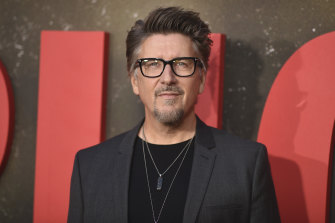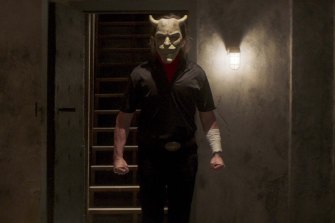“The movie’s really set in my childhood,” Derrickson says. “I grew up in North Denver, Colorado and I was Finney’s age in 1978. There was a lot of violence in the air. I got bullied a lot… and all the kids on my block got beat by their dads – some of them got a lot worse than others.
“I remember one kid running up to my garage one day sobbing. He had these bloody welts all across the back of his legs because his father whipped him with an extension cord. I remember just saying, ‘Oh, that’s terrible’… and then we went and played Nerf football.
“At that time, it really was the norm – at least in my experience,” Derrickson says. “The main emotion that I associated with my own childhood was fear.”

“The main emotion that I associated with my own childhood was fear,” says director Scott Derrickson.Credit:Richard Shotwell/Invision/AP
This was exacerbated by current events too, he says. A number of high-profile cases of missing children popularized the idea of “stranger danger”, Ted Bundy had brutally killed many young women in the area, and the Manson murders were fresh in everyone’s minds.
“There was this fear of ‘the serial killer’,” Derrickson says. “Someone who can just snatch you in the night and snuff you out. The kids in my neighborhood were living with that fear all the time. We all talked about it.
“You would stare at [missing] kids’ faces on the milk cartons at breakfast every morning.”

Ethan Hawke as the Grabber in The Black Phone.Credit:Universal Pictures
Derrickson feels that the nostalgia people feel for this period is sometimes drawn from popular culture more than anything else – specifically Steven Spielberg’s “suburban childhood portrayals” (which, in turn, is a major touchpoint for stranger things).
“We were really setting out to make a reverse Amblin movie,” Derrickson says, referring to Spielberg’s production company, Amblin Entertainment, which was synonymous with feel-good hits like ET and The Goonies.
Though the film has many of the aesthetic and thematic hallmarks of these movies – plucky pre-teens riding bikes, playing baseball and banding together to try and save the day – its depiction of the world and its varied dangers is much darker.
loading
And, with the movie collecting more than $200 million in global box office takings (off an approximate budget of $24 million), that approach is clearly resonating.
“I think that getting an original horror film to pop the way that this movie has is difficult,” Derrickson says. (The director has worked extensively in the genre, and is known best for Deliver Us From Evil, The Exorcism of Emily Rose and Sinister – as well as 2016’s Doctor Strange).
“The crowd reactions to this movie have superseded anything else that I’ve done,” Derrickson says. “There’s a lot of cheering and clapping [at various points] and a lot of laughter too.”
Much of that can be put down to the kids’ performances – particularly McGraw, who is phenomenal as the quick-witted and foul-mouthed Gwen – but Derrickson notes it’s a natural part of the horror experience too.
Though nostalgia may be comforting (especially during times when comfort is in short supply), he says there’s real use in honestly confronting the “terrible things” in our past as well.
“I don’t believe that horror films create fear – they release it. That’s why after a good scary movie, people are coming out of the theater laughing.
“I think it can be a very healthy and very cathartic experience.”

